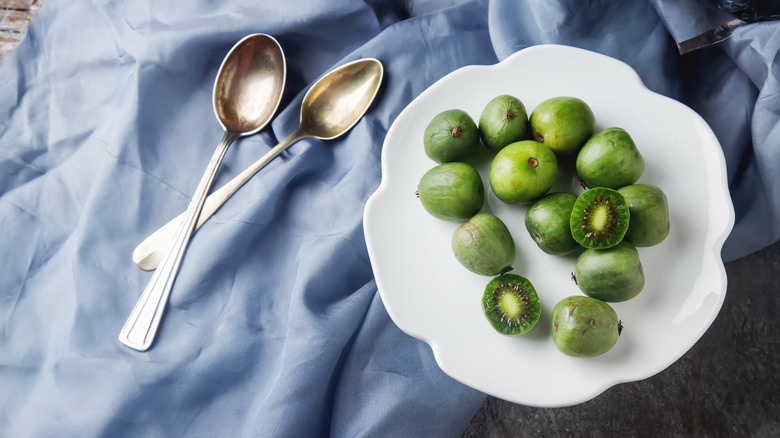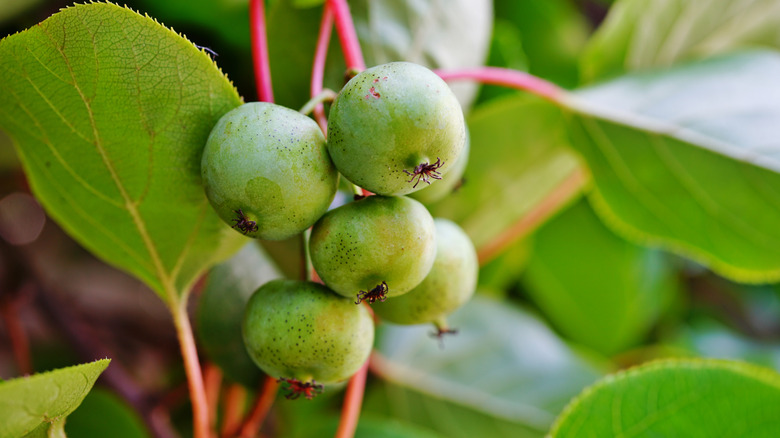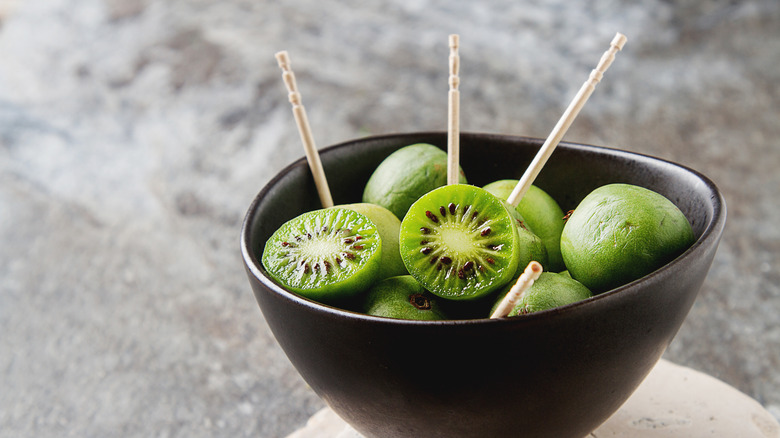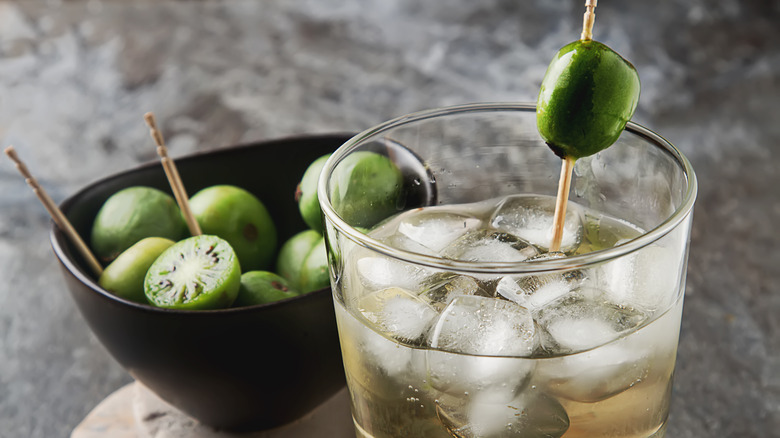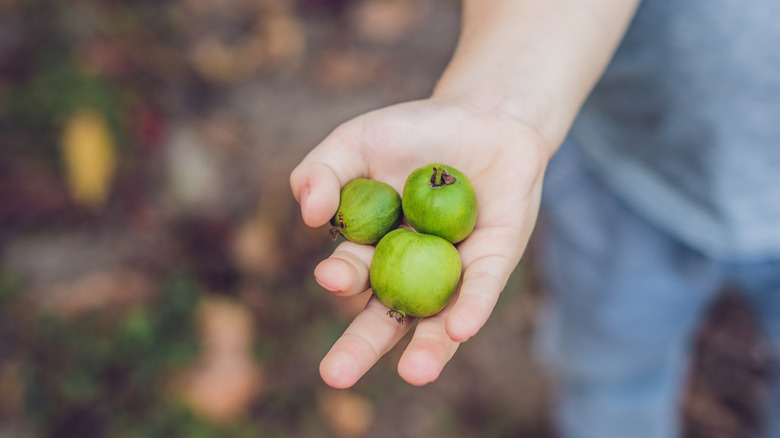What Are Nergi Berries? The Fruit That Looks Like Grape-Sized Kiwi
Whether you're always up to date with the latest health craze or simply trying to incorporate a few good-for-you foods into your regular diet, you've likely come across the term "superfood." While lists of the best "superfoods" are often ever-changing fads that many experts say are no more nutrient-packed than other foods, there are still a few reasons to incorporate them into your meals.
While some of the miraculous marketing claims of certain superfoods fall short of reality, most superfoods still have considerable health benefits. There are foods with loads of healthy fats, like avocados and salmon, there's vitamin-abundant kale and antioxidant-rich fruits, like açai and goji berries. However, we're here to tell you about another sweet-tasting, lesser-known berry with just as many reasons to buy them by the pound: nergi berries.
These small, round fruits are the perfect low-maintenance snack for changing your typical routine. And, since they're a cross between two of your favorite fruits, we're sure they've already won you over without you even having tried them.
What are nergi berries
If you're from North America, it's likely you've never heard of a nergi berry, also known as a kiwi berry or Actinidia arguta, before. That's because this fruit is native to Asia. The northernmost regions of Asia have grown this fruit for centuries. Cold places such as Siberia and parts of Japan and China have long enjoyed this unique fruit. However, in more recent years, the nergi berry has been grown commonly across Europe and North America. Countries like France and Spain and North America's New England region have climates adequate for growing this fruit.
Nergi berries have a tough yet smooth skin that's light green in color with yellow and brown spots. When cut open, the inside of these fruits look similar to a kiwi's cross-section. Nergi berries are often compared to kiwis and said to look like a miniature, hairless version of the fruit, while others note that the skin appears more similar to that of a typical green grape. And these berries happen to taste like a cross between the two fruits.
What does nergi berries taste like
The taste of the nergi berry is not as straightforward as you might think. This fruit is said to taste like a bit of a cross between a traditional kiwi and a grape, just like it appears. However, the flavor is undoubtedly complex, and you'll likely draw your own conclusions about what exactly this fruit tastes like. The berry is quite sweet, but a strong acidity also compliments the sugary, fruity flavor.
When the berries are soft is when they will taste the best. They will become increasingly sweet as they ripen and start to lose their more sour notes that make you crinkle your nose. Nergi berries are also quite juicy on the inside, making the experience of snacking on them quite fun. However, an overripe nergi berry is not the most pleasant experience, either. So ensure you know how to source an in-season variety before tossing one into a dish or drink.
How to cook with nergi berries
If you're a fan of whipping up smoothies or fruit bowls but hate the tedious task of peeling and dicing, you'll love cooking with nergi berries. Unlike kiwis, cutting the fuzzy skin off these fruits is unnecessary. They can be rinsed off, thrown into your blender, or cut into smaller pieces. They make a great addition to a fruit smoothie and can even be added to salads, sauces, and jams. Basically, anywhere you'd throw fresh-cut strawberries or apple slices, you can also experiment with adding nergi berries.
These berries are also a great size to garnish any homemade cocktails that would benefit from such a pairing. They work great skewered atop your best cocktails, mocktails, and other beverage creations. However, you're also welcome to snack on the fruit. After they're washed off, they can be eaten whole or cut into halves. But before you start popping fistfuls of these berries into your mouth, you must know where to buy them.
Where to buy nergi berries
If you plan on hunting through your local grocery store to find these berries, you may be in luck. Plenty of big box stores, including Sam's Club and Trader Joe's, carry these fruits. It's also possible that your nearby co-op or farmer's market has a stand with the berries piled high.
It's worth noting that these fruits are in season in the fall months, unlike other berries whose prime is the summertime. Their short harvest season occurs in August and September when they're incredibly juicy and ripe. So, if you're having trouble finding them in stores, try again when these months roll around.
Like most berries, they will likely be found in plastic or cardboard punnets in the imported or unique fruit section. A ripe berry will still be somewhat firm but also have give when touched. They can be kept at room temperature once purchased, but if you're not planning on cutting up and using all your berries in one day, it's worth sticking them in the fridge or even freezing them.
Nutritional information about nergi berries
As previously mentioned, these berries have often been dubbed a superfood. This means that frequently eating these berries can have myriad health benefits. Nergi berries are packed with vitamins and minerals and contain high levels of vitamins C and E. Vitamin C helps with body tissue repair and has immune system benefits, while vitamin E has plenty of advantages for your vision, brain, blood, and more. This fruit also includes minerals such as magnesium and potassium. Similarly, nergi berries are rich in antioxidants, which are thought to reduce the risk of diseases, including cancer and heart disease.
It's also worth incorporating nergi berries into your diet if you're trying to increase your fiber intake. Being high in fiber, this berry has many benefits, including aiding your digestive system.
So, if you're looking to have a new go-to fruit in your diet that's not only good for you but also tastes good, then it might be worth searching for this underrated fruit in your grocery store aisles.
